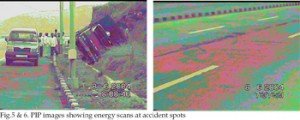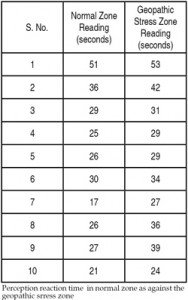Pimplikar’s findings that geopathic stress zones could lead to a higher incidence of accidents were corroborated by Avinash Kharat in his paper “Theoretical and Empirical Investigations on Built Environment”. The paper, published in 2000, documented the results of his research on accidents on the Mumbai-Pune, Pune-Nagpur, Pune-Bangalore and other highways. He found by dowsing with L-rods that there were underground water veins at many high-frequency accident spots along these highways. He also demonstrated that the PIEV (Perception, Intellection, Emotion and Volition) time, also known as Perception Reaction Time, of the drivers increased in the geopathic stress zones, leading to increased incidences of accidents.
 The Perception Reaction Time is the time that a driver needs to see a hazard, recognise it, decide on an evasive action, and finally initiate the action. Higher the time, slower is the driver’s response. Kharat practically demonstrated it using an instrument he devised and called the Geo Induced Reaction Time (GIRT) instrument. The GIRT instrument consists of two small boxes. The first box, given to the driver being tested, has an arrangement of two lights – one red, and the other green. The driver has to press a switch on the instrument when one of the lights turns on. The second box, with the person testing the driver, has a stopwatch that records time up to 1/100th of a second, a reset switch, and two switches to put off either the red light or green light. With another switch, the tester activates the LED of the desired colour. The time that elapses when either of the lights comes on and the driver presses the switch is the PIEV or the Perception Reaction Time. Kharat found significant changes in the Perception Reaction Times, as seen in a sample of the results shown the table above.
The Perception Reaction Time is the time that a driver needs to see a hazard, recognise it, decide on an evasive action, and finally initiate the action. Higher the time, slower is the driver’s response. Kharat practically demonstrated it using an instrument he devised and called the Geo Induced Reaction Time (GIRT) instrument. The GIRT instrument consists of two small boxes. The first box, given to the driver being tested, has an arrangement of two lights – one red, and the other green. The driver has to press a switch on the instrument when one of the lights turns on. The second box, with the person testing the driver, has a stopwatch that records time up to 1/100th of a second, a reset switch, and two switches to put off either the red light or green light. With another switch, the tester activates the LED of the desired colour. The time that elapses when either of the lights comes on and the driver presses the switch is the PIEV or the Perception Reaction Time. Kharat found significant changes in the Perception Reaction Times, as seen in a sample of the results shown the table above.
Kharat says, “The effect of geopathic stress on PIEV time of a driver is a critical factor in causing accidents. If geopathic stress is taken into account in the planning of roads, then many accidents can be avoided and precious lives can be saved.”
 Another technique used by Pimplikar to study the effect of geopathic stress on drivers and pavements is Polycontrast Interference Photography (PIP), invented by the British researcher-scientist Harry Oldfield. PIP uses a scanner that gives a real-time, moving image of the interaction of the Energy Field of an object and ambient light photons. According to the theory of Energy Field all bodies, living and non-living, are composed of energy fields, on which atoms and molecules are strung. The Energy Field is said to be a combination of electromagnetic and bio-dynamic radiations that can be located on the electromagnetic spectrum. An analysis of the energy field reveals the physiological and psychological state of an individual, and flaws, imperfections and distresses in non-living structures. The image obtained by PIP grades the intensities of light reflected from the object under analysis into very fine levels, which are otherwise not visible to the naked eye. Pimplikar found that at places along the Mumbai-Pune expressway where there was no geopathic stress, the PIP images of the pavements displayed high frequency (fast vibrating) colours from the green, greenish blue and violet light spectrum, indicating energetic condition and good physical health of the pavement.
Another technique used by Pimplikar to study the effect of geopathic stress on drivers and pavements is Polycontrast Interference Photography (PIP), invented by the British researcher-scientist Harry Oldfield. PIP uses a scanner that gives a real-time, moving image of the interaction of the Energy Field of an object and ambient light photons. According to the theory of Energy Field all bodies, living and non-living, are composed of energy fields, on which atoms and molecules are strung. The Energy Field is said to be a combination of electromagnetic and bio-dynamic radiations that can be located on the electromagnetic spectrum. An analysis of the energy field reveals the physiological and psychological state of an individual, and flaws, imperfections and distresses in non-living structures. The image obtained by PIP grades the intensities of light reflected from the object under analysis into very fine levels, which are otherwise not visible to the naked eye. Pimplikar found that at places along the Mumbai-Pune expressway where there was no geopathic stress, the PIP images of the pavements displayed high frequency (fast vibrating) colours from the green, greenish blue and violet light spectrum, indicating energetic condition and good physical health of the pavement.
Fig.7. HEF scans of subject: a) at rest before dowsing; b) during dowsing; c) at point of entry into stress zone; d) and e) brighter scans caused by longer exposure to geopathic stress.
 However, at places where an accident occurred, the image showed an overwhelming presence of red colour light which is a much lower frequency (slower vibrating) colour, and the pattern abruptly changed from greenish blue to red, indicating a significant lowering of the energies of the particles of the pavement, and that the pavement was being subjected to differential stresses due to the geopathic stress.
However, at places where an accident occurred, the image showed an overwhelming presence of red colour light which is a much lower frequency (slower vibrating) colour, and the pattern abruptly changed from greenish blue to red, indicating a significant lowering of the energies of the particles of the pavement, and that the pavement was being subjected to differential stresses due to the geopathic stress.
Similarly, Pimplikar also mapped the effect of geopathic stress on the energy field of a person (Human Energy Field or HEF) in a normal zone and a geopathic stress zone, as shown in fig7. He found that a driver shows high mental activity when he is in a geopathic stress zone. Over a period of time, his HEF shows variations while he is in the zone. He noted that when the original human energy field interferes with the electromagnetic radiations at the point of entry into the stress zone, vertical bands of yellow and bluish white occur . When the driver/subject senses the radiations on the stress zone, as against the normal HEF, the HEF gets brighter. These observations correlate well with the result observed earlier that the Perception Reaction Times of drivers change (increase) in geopathic stress zones, a potential factor in causing accidents.
We would recommend that the geopathic stress should be considered as an additional design parameter quite early on in road design. This will enable modification of IRC codes on road design and maintenance.
Recommendation
Based on his extensive research findings, Pimplikar opines, “We would recommend that the geopathic stress should be considered as an additional design parameter quite early on in road design. This will enable modification of IRC codes on road design and maintenance. More research should be carried out. Validated empirical equations if developed, as I have indicated, will certainly help in accidents forecasting at black spots and also in deciding the effectiveness of the stress nullification strategies subsequently adopted at black spots.”
 TrafficInfraTech Magazine Linking People Places & Progress
TrafficInfraTech Magazine Linking People Places & Progress